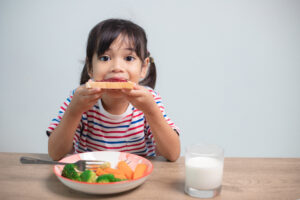In my role as a childhood educator I’ve embarked on a colorful journey, quite literally. This post encapsulates a philosophy I’ve championed throughout my career.
This approach isn’t just about creating visually appealing meals; it’s about enriching our little ones’ diets with a spectrum of nutrients essential for their growth and development.
Drawing from my experiences, I’d like to share the magic behind and methods for integrating a rainbow of foods into your child’s daily meals.
The Importance of a Colorful Diet
Delving into the significance of a colorful plate, it’s clear that each hue represents a unique set of nutrients critical for a child’s well-being.
Why Every Color Counts
Each color in fruits and vegetables is linked to specific nutrients. For example, the deep blues and purples in blueberries are indicative of antioxidants, while the vibrant orange in carrots signals a rich source of beta-carotene.
In my practice, I’ve found that illustrating these color-nutrient connections encourages families to diversify their diets, laying a foundation for healthy eating habits.
Making Nutrition Fun
My adventures in childcare have taught me the power of making nutrition an enjoyable discovery process.
When children understand the ‘why’ behind their meals and view eating as a fun activity, they’re more open to trying new foods and developing a positive relationship with eating.
Incorporating the Rainbow into Daily Meals
Crafting a diet that spans the colors of the rainbow can be an exciting culinary adventure. Here are some strategies I’ve employed and recommend for weaving vibrant hues into every meal.
Start with Breakfast
Beginning the day with a burst of color not only provides essential nutrients but also sets a joyful tone for the day. A simple yet effective option is a fruit and vegetable smoothie—a hit among kids for both its taste and array of colors.
Snack Time Color Splash
Transforming snack time into a rainbow-themed feast is easier than you might think. Offering a variety of vegetable sticks and fruit slices with appealing dips turns a mundane snack into an exciting, nutritious treat.
Colorful Main Dishes
Main meals offer a canvas for creativity, incorporating vegetables and fruits to create a meal that’s as delightful to look at as it is to eat. I’ve found that even simple additions like mixed vegetables to pasta or colorful toppings on pizza can significantly enhance a dish’s appeal and nutritional value.
Engaging Kids in the Kitchen
One of the most effective ways to foster a love for healthy, colorful eating is to involve children in the meal preparation process.
This hands-on approach not only educates them about different foods but also instills a sense of pride and ownership over their dietary choices.
Grocery Shopping as a Learning Experience
Taking children along for grocery shopping can turn a routine chore into an educational outing. It’s an opportunity to teach them about various fruits and vegetables, encouraging them to pick out new colors to try at home.
Gardening Together
If space allows, gardening can be a rewarding way to connect children with the source of their food. Growing their own fruits and vegetables can heighten their interest in trying what they’ve cultivated, naturally incorporating more colors into their diet.
Final Thoughts
Through my years of nurturing young minds and bodies, I’ve witnessed the profound impact that a colorful, balanced diet can have on children’s health, happiness, and eagerness to learn.
Eating the rainbow isn’t just a dietary guideline; it’s a pathway to instilling lifelong healthy eating habits.
With patience, creativity, and a little bit of fun, we can guide our children to not only appreciate the wealth of nutrition in their meals but also to enjoy every bite along the way.












